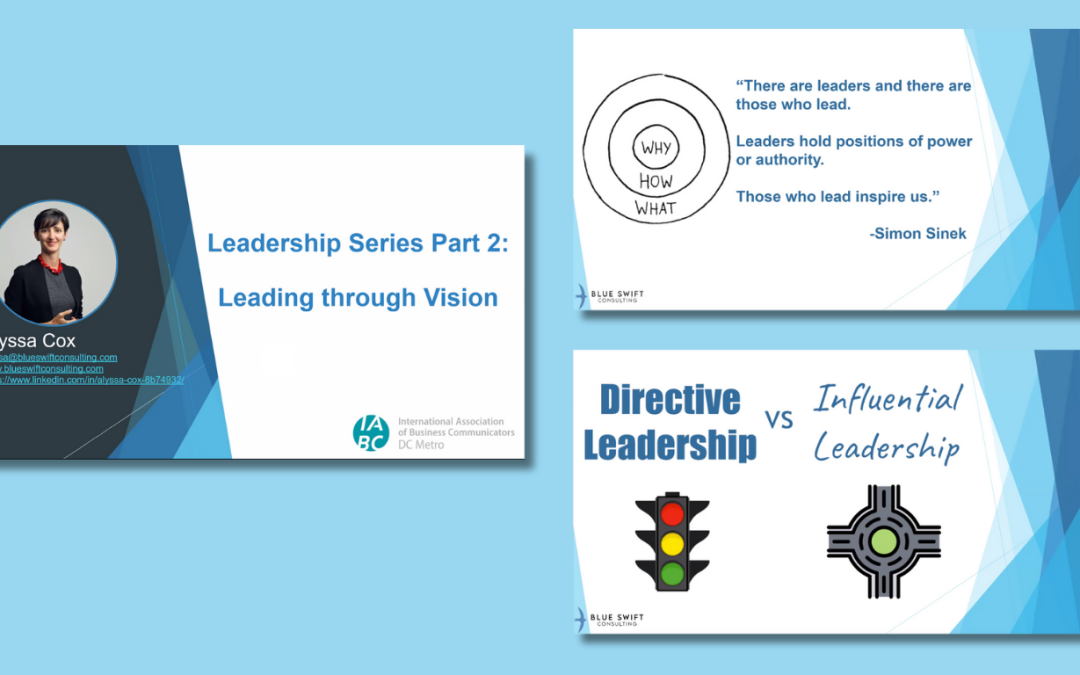Alyssa Cox of Blue Swift Consulting discussed the importance of setting a path that speaks to how an organization drives progress toward its overarching mission at IABC DC Metro’s “Leading Through Vision” on May 17. The webinar was the second of the chapter’s two-part leadership series.
“Vision helps us articulate what we need to be working on and it gives us guidelines for making strategic decisions for how we spend our time, where we deploy resources, and how we define success,” she said.
The webinar built on the first portion of the chapter’s leadership series, “Establishing a Leadership Brand,” which Alyssa conducted on April 19. Click here for an overview.
An outline of “Leading Through Vision”:
1) What is Vision?
Alyssa quoted Simon Sinek, an author and inspirational speaker, who said: “There are leaders and then there are those who lead. Leaders hold positions of power or authority. Those who lead inspire us.”
Building on Sinek’s thought, she noted it’s crucial that managers help their employees understand how the work they do fits into an organization’s larger goals. Once they grasp this, it will help drive success and achievement.
2) Directive Leadership vs. Influential Leadership
A) Directive Leadership: Alyssa referred to directive leadership as “stop light leadership” in that tasks are distributed, activity is controlled, and decisions are made. When we work with directive leaders we like, we call them “perfectionists.” When we work with directive leaders we don’t like, we call them “micromanagers.” But it comes down to the same idea: decisions are concentrated on the leader. And the best that you’re likely to receive from a directive leader is a task list.
B) Influential Leadership: On the other end are influential leaders. These are people Alyssa calls “traffic circle leaders.” The objective of a roundabout is to get drivers through safely. Whereas a directive leader puts up a stoplight and directs traffic, an influential leader sets up a system where people can determine their own outcome. There are no stoplights at a traffic circle — you know the direction and the goal, and it’s up to you to make the right decisions.
3) Vision:
“Your vision should go beyond tactics,” Alyssa said. “How do we articulate a plan for your team? It starts with a vision for your whole organization. And it’s not about profits — it’s about the larger social good that your organization is trying to achieve.”
For example, the mission of Unilever, a multinational producer of consumer goods, is: “To make sustainable living commonplace with high-performing brands that are a force for good, taking action for a more sustainable and equitable world.”
While Unilever’s holdings include Dove, Ben & Jerry’s and Hellman’s, their mission doesn’t mention soap, ice cream, or mayonnaise. Instead, it speaks to how the company wants to contribute to the world, and their products are what allow them to arrive at that place.
4) Your Organization’s Purpose:
How does your team service the customer? Who do you interact with and how do you create a human chain to the client?
Every organization has a path that leads to the customer whether you work for a for-profit, not-for-profit, or government enterprise. Depending on where your team sits in the operation, this chain can be shorter or longer; some employees interact with the customer directly and others are a layer or two removed from the client. As you distill your organization’s purpose by role, don’t start with your own work. Instead, begin with those who are closest to the customer and work your way backwards.
5) A Sample Vision Statement for Unilever’s HR Comms Department:
A) Unilever’s mission: “To make sustainable living commonplace with high-performing brands that are a force for good, taking action for a more sustainable and equitable world.”
These teams drive the organization’s purpose by…
B) HR Comms: … ensuring the people responsible for designing, manufacturing, and delivering our products understand the organization values them and know what resources are available to help them be successful, both at work and at home.
C) HR: … ensuring the people responsible for designing, manufacturing, and delivering our products have the resources they need to be successful, both at work and at home.
D) Frontline Employees: … designing, manufacturing, and delivering the high-performing products that make people’s lives better every day.
E) Customer
6) After Completing Your Vision Statement:
A) Refine:
__ Sleep on your answers
__ Add personal stories
B) Audit:
__ Sense check your vision
__ Update as necessary
C) Socialize:
__ Communicate with your team
__ Incorporate your vision into communication with your direct customer collaborators
“As you’re looking at your goals and evaluating your performance throughout the year, speak to this vision, as well as people’s ability and willingness to work toward it,” Alyssa said. “That’s how it starts to come to life and begins to become part of the cultural fabric of how we work and what we believe.”
Thank you to Alyssa for imparting her expertise. IABC DC Metro looks forward to collaborating on future events.
To learn about Alyssa’s organization, Blue Swift Consulting, and the services it offers — consulting, workshop facilitation, and keynote speaking — visit: blueswiftconsulting.com. You can also email: alyssa@blueswiftconsulting.com or call: 919-610-1595.
